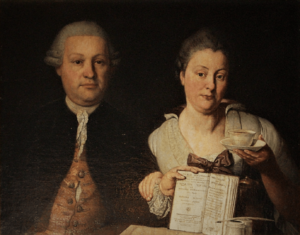Leopold Auenbrugger facts for kids
Quick facts for kids
Leopold Auenbrugger
|
|
|---|---|

Leopold Auenbrugger and his wife Marianne
|
|
| Born | 19 November 1722 Graz, Duchy of Styria
|
| Died | May 17, 1809 (aged 86) |
| Nationality | Austrian |
| Known for | percussion (medicine) |
| Scientific career | |
| Fields | medicine |
Josef Leopold Auenbrugger (born November 19, 1722 – died May 17, 1809) was an Austrian physician. He invented a special way to check on patients called percussion. This discovery helped doctors understand diseases better. Because of his work, he is seen as one of the people who helped start modern medicine.
Contents
Early Life and Education
Leopold Auenbrugger was born in Graz, a city in the Austrian province of Styria. His father owned an inn called Zum Schwarzen Mohren. He made sure Leopold got a great education in his hometown. Then, Leopold went to Vienna to study at the university.
Auenbrugger became a doctor when he was 22 years old. After that, he worked for ten years at the Spanish Military Hospital in Vienna.
His Big Discovery: Percussion
While working at the hospital, Auenbrugger made an important discovery. He found that if he gently tapped on a patient's chest and listened carefully, he could tell how dense the body parts and organs underneath were.
He got this idea from watching his father. His father would tap on wine casks in the cellar to see how much wine was left inside. Auenbrugger realized he could use a similar method for people. With this new technique, he could even figure out the size and shape of the heart.
This was a huge step forward! For the first time, a doctor could get a good idea of what was happening inside a patient's body without surgery. He wrote a small book about his findings, but at first, not many people paid attention.
Over ten years, Auenbrugger kept studying his patients. He checked his percussion findings by comparing them with what he saw when studying bodies after death. This helped him prove that his method worked.
Other Important Work
Auenbrugger also found a special sign, now called Auenbrugger's sign. This is when the upper belly area (the epigastric region) bulges out. It can happen if there's a lot of fluid around the heart in the pericardium, which is the sac that surrounds the heart.
Later, he focused on tuberculosis, a serious lung disease. He learned how to find hollow spaces, called cavities, in the lungs using percussion. He could even tell where they were and how big they were.
He also discovered that by placing a hand on the chest, doctors could feel vibrations. These vibrations, called fremitus, are made by the patient's voice and breath. This helped him understand more about the condition of the lung tissue.
He published these observations in a book with a long title: Inventum Novum ex Percussione Thoracis Humani Interni Pectoris Morbos Detegendi. In English, this means "A New Discovery that Enables the Physician from the Percussion of the Human Thorax to Detect the Diseases Hidden Within the Chest." This book was a major event in the history of medicine.
A Lasting Legacy
Like many new discoveries, Auenbrugger's percussion method was not immediately popular. But before he died, a French doctor named René Laennec became interested in his ideas. Laennec then went on to invent auscultation, which is listening to sounds inside the body, often with a stethoscope.
Later, other doctors recognized how valuable percussion was. Jean-Nicolas Corvisart helped make it well-known by teaching it to his students in France. Joseph Škoda in Vienna also helped. He even translated Auenbrugger's book into German in 1808, which made Auenbrugger's work much more famous.
Leopold Auenbrugger lived to be 86 years old. He was known for being friendly with younger doctors and for being kind to poor people and those with tuberculosis. He passed away in 1809.
Auenbrugger's daughters, Marianna and Katerina, were talented composers. Marianna even studied music with the famous composer Antonio Salieri.
See also
 In Spanish: Leopold Auenbrugger para niños
In Spanish: Leopold Auenbrugger para niños

